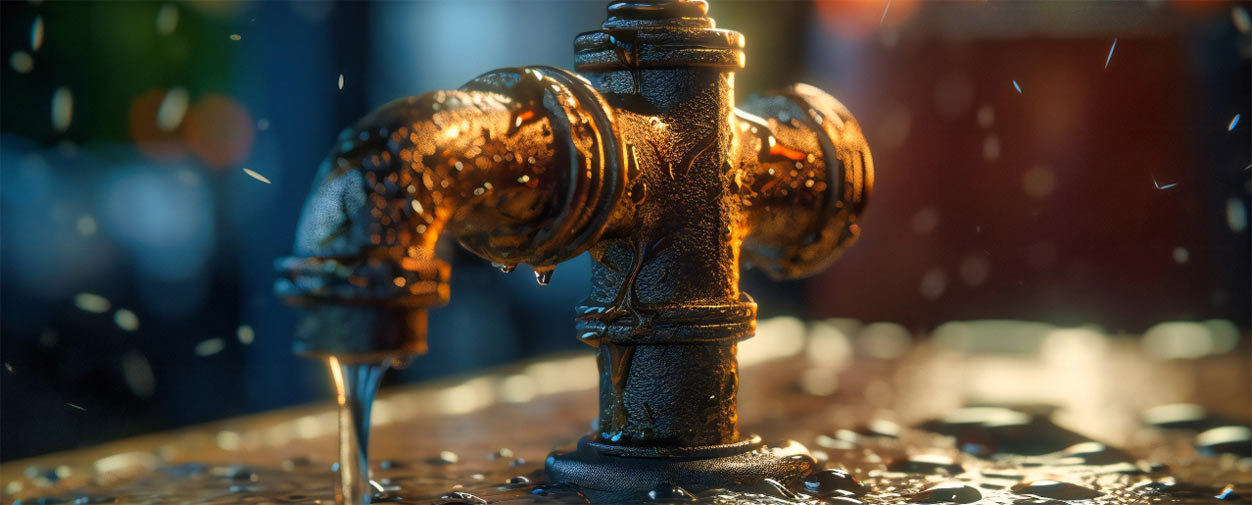Nitrogen Treatment VS Huguenot Inhibitor
- City Water
- Nitrogen Treated
- Huguenot Treated
- 030 MILS Coupon E
- 0.41 MILS Co
- 0.13 MILS €

Our Proguard treatment reduced corrosion rates 68% below that of a Nitrogen treated fire sprinkler system.
Contrary to popular belief, nitrogen gas treatment does NOT control corrosion, kill bacteria, or reduce dissolved oxygen content.
Other companies claim to have an electronic device that is a corrosion monitoring system. Unfortunately, all this device does is alert you when your piping system has lost 30% due to corrosion.
By contrast, a corrosion management program supplied by Huguenot gives real time data in 90 day increments of corrosion rates per ASTM guidelines, with accuracy down to 0.01 Mils Per Year (MPY).
Huguenot Labs offers the industry’s only performance-based guarantee that assures corrosion rates are maintained at a maximum sustained rate of 2.0 Mils Per Year.
Fire Sprinkler Corrosion Facts
Important Facts About Nitrogen in Fire Sprinkler Systems
Did you know 1000 gallons of water can create (Corrode) 32.5 pounds of Iron Oxide in just 30 days? That means that iron from your steel pipe is being converted to iron oxide. Iron oxide is a key component found in deposits discovered in fire sprinkler systems. Analysis of deposits in fire sprinkler systems confirms that 90% of the deposited material found in fire sprinkler systems is iron oxide (what is left of your steel pipe).
What you really need to know about cleaning and treating your fire sprinkler system.
The cleaning and treatment of fire sprinkler systems have been a challenging process for most to understand. Different companies have recently tried to use conventional cooling tower and boiler treatment technologies with limited or no success. The confusion in the industry is widespread and becoming more complicated by the day.
Wet and dry pipe sprinkler systems operate in completely different ways and have individual corrosion problems that are just as varied. Fire sprinkler systems are unlike any other water-based piping system both wet and dry. The wet fire sprinkler systems are filled with stagnant oxygen-rich waters that are then held at relatively high pressures (150 to 175 psi). The typical wet fire sprinkler system design is one that has many high point areas where trapped air is likely. The presence of trapped air in a pressurized fire sprinkler system can create a unique environment where the remaining Oxygen is pressed back into the water. Oxygen at atmospheric pressure will dissolve naturally or equilibrates into the water at a recorded concentration of 8 Parts Per Million (PPM). The fire sprinkler system with trapped air held at an operating pressure of 175 psi will see elevated dissolved oxygen levels of 35 to 40 PPM in these high-point air entrapped areas. This high oxygen content creates an environment where the steel pipe can quickly corrode. Corrosion by-products create deposits that can quickly lead to conditions considered favorable for advanced bacterial growth. Bacterial colonization of deposits leads to the creation of organic acids that quickly destroy any steel it comes in contact with. Once a failure or pinhole leak is discovered, wet systems are typically drained and repaired, and then refilled with more oxygen-rich waters. This continues to advance the destructive corrosion process in your fire sprinkler system.

Understanding this complex environment and the corrosion processes involved is the only way a concise corrosion mitigation plan can be developed. The dry or preaction fire sprinkler systems have corrosion issues completely different from what is witnessed in wet sprinkler systems. Condensing waters from the air compressor source is acidic with no buffering ions present. This low pH environment coupled with the fact that there is an overabundant source of Oxygen creates a corrosion environment where the only limiting factor to stop the corrosion process is the steel or iron pipe.
The assessment of your fire sprinkler system is a critical first step in determining the path to a successful cleaning and treatment program. A single drum treatment program can not and will not address the complex corrosion processes that occur in the many different fire sprinkler systems. Proper cleaning of a fire sprinkler system is a process that other over corrosion mitigation companies commonly overlook. The failure to properly clean a fouled sprinkler system will only lead to future problems. Other single drum treatment programs completely miss the point of controlling corrosion. They sterilize the system while providing no protection from corrosion. This readily available technology also presents significant health risk concerns if a release of a sprinkler head should occur. Other boiler-like treatment programs pretend to control corrosion by simply elevating the pH of the water within your fire sprinkler system. The elevation of the water’s pH completely misses the sheer fact that soft metal components like brass, copper, and bronze all become subjects to a high pH corrosion attack know as dezincification.
The bottom line is to pick a corrosion mitigation company that has developed technologies to better the industry, not just put a band-aid on a particular problem.
Through years of research and development, Huguenot Laboratories has set the standard for the cleaning and treatment of water-based fire protection systems. This proprietary environmentally friendly technology has been adopted as the “best practice program” for addressing corrosion in fire sprinkler systems. Our cleaning and treatment programs are proven technologies that are backed with the industry’s only money-back performance guarantee.